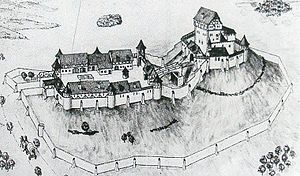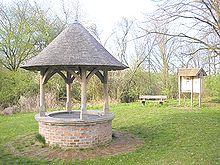Zusameck Castle
| Zusameck Castle | ||
|---|---|---|
|
Reconstruction of the entire complex (E. Högg) on an information board in the castle area |
||
| Creation time : | 9th century | |
| Castle type : | Höhenburg, spur location | |
| Conservation status: | Burgstall | |
| Place: | Shards of spelled | |
| Geographical location | 48 ° 21 '7.7 " N , 10 ° 35' 38.2" E | |
| Height: | 533 m above sea level NN | |
|
|
||
The remains of the high to post-medieval castle Zusameck are located on the Schlossberg (Kalvarienberg) north of the Dinkelscherben market in the Augsburg district in Swabia . The extensive hill fort was abandoned in 1812 and demolished except for the castle chapel .
history
The Burgplatz was already settled during the Neolithic Age. Some ceramic shards that were found document the continued use of the settlement area in the late Celtic period. An early medieval wood and earth castle from the 9th century was replaced in the 10th or 11th century by a wooden hilltop castle typical of the time .
The first stone fortress on the hill above the settlement was built in the 12th century as the seat of a servant family of the Margraves of Burgau . From 1231 to 1301 these “milites de zuemekke” appear several times in the written sources. The residential tower of the family was built from Nagelfluh ashlars . In the Augsburg area, this conglomerate rock is often just below the soil surface or jumps out of the valley slopes. Later renovations and extensions of the castle were made of brickwork.
At the beginning of the 14th century, the von Zusameck family seems to have died out. In 1301, Ulrich von Zusameck was the last bearer of the name.
The margraves then pledged the fiefdom to Hans von Hattenberg and Burkhard von Ellerbach the Younger. In 1333/43, the Augsburg bishop Ulrich von Schönegg finally acquired the rule for the Augsburg bishopric .
The castle over the Zusamtal was destroyed for the first time in 1388 during the “ city war ”. The troops of the imperial city of Augsburg stormed the residence after Bishop Burkhard von Ellerbach had ordered an attack on an imperial city trade train.
After the restoration, the facility was pledged several times. In 1430 the Augsburg cathedral chapter bought the castle. 1485 awarded Emperor Friedrich III. the cathedral chapter the blood spell for the rule of Zusameck. From 1540 the prisoners of the associated court were allowed to be imprisoned on the fortress.
During the " Schmalkaldic War " the Augsburg field captain Sebastian Schertlin von Burtenbach occupied the castle on July 19, 1546. Schertlin wanted to establish himself as the imperial city caretaker on Zusameck and claimed the tithe of the rule. When the Schmalkaldic League collapsed just a year later, however, the captain was imprisoned in the Augsburg Fronhof.
As a result, a castellan of the cathedral chapter administered the castle and manor. In 1575 a senior bailiff was set up, which in 1725 was elevated to a nursing office. When the foster seat fell to the Bavarian state in the course of secularization in 1803 , the castle was already in a very poor condition. Parts had to be broken off as early as 1801. After the transition to Bavaria, the outer wall was demolished. The castle buildings served as a criminal prison until 1812. This year it was decided to abandon the complex, which was then demolished except for the chapel. As in other places, the ruins were a welcome quarry for the population, so that only small remains of the curtain wall can be seen today. A large part of the stone material was also removed for the construction of the Augsburg-Ulm railway line.
Around 1850 the preserved castle chapel was renovated and redesigned in a neo-Gothic style. At the same time, the Stations of the Cross to the chapel were built under Pastor Egger. In 1852 the Calvary was added on the plateau of the main castle cone.
In 1968, the working group for prehistory and early history of the Augsburg district was able to draw up a topographical survey of the castle grounds. A little later, a sports field was laid out in front of the outer bailey and the northern neck ditch was also leveled. Since then, only the main castle cone with the chapel tells of the history of the Burgplatz.
1979 to 1985 the area of the main castle was archaeologically examined by the working group for prehistory . The Heimatverein Reischenau reconstructed part of a wall tower in 1986/87, renovated the chapel and the stations of the cross. In 1999/2000 the Heimatverein renewed the castle fountain . The shaft was cleared of rubble to a depth of 29 meters. 36 meters are still buried. After the renovation measures by the Heimatverein, the entire castle complex is in good condition again.
description
The castle consisted of a rectangular outer bailey (approx. 65 × 40 meters) in the northwest, which was in front of a mighty, almost circular tower hill (base width approx. 60 meters). The plateau of the main castle was about 30 x 30 meters. On the main castle cone stood a high medieval tower house, which was originally only secured by palisades . In the following centuries this residential tower was rebuilt and expanded several times. In the middle of the 19th century, the still preserved Calvary group was erected here. In the course of the restoration of the castle complex around 2000, the renovated group was moved to the north side of the main castle cone.
The Gothic chapel was in the southeast in a circumferential ring wall involved which the tower house kennel-like surrounding.
The spacious outer bailey was also secured with a tower-reinforced curtain wall. The towers were designed as shell towers . The back of the castle courtyard was open so that an enemy who had penetrated could not hide. Side walls and a bridge partially designed as a drawbridge connected the outer and main castle. The foot of the castle hill was also surrounded by a low, towerless wall.
A pen drawing (circle of Jörg Breu the Elder) in the holdings of the Germanic National Museum in Nuremberg gives a good impression of the former castle complex from around 1520 (Fig .: Pötzl, p. 53). The medieval residential tower at that time apparently had a cantilevered upper floor made of half-timbered houses . To the east of the tower, a high shield wall with battlements secured the narrow courtyard. The excavations of the Working Group for Prehistory and Early History in Augsburg indicate, however, two residential buildings. The drawing served E. Högg together with documents from H. Gutmann and Otto Schneider as the basis for a graphic reconstruction of the entire complex, which Walter Pötzl published in his Heimatbuch in 1987 (p. 63).
On the north side of the main castle, a short wall made of smaller Nagelfluh blocks was exposed. The other foundations visible today and the shell tower in the northwest are modern masonry. A commemorative plaque for the honored homeland and castle researcher Otto Schneider (1927-2000) is embedded in the foundation of the residential tower.
The Bavarian State Office for Monument Preservation lists the soil monument as a settlement from the Neolithic and the Latène period and as a medieval castle stables under monument number D 7-7629-0016.
Former castle chapel of the Holy Cross
The building, which is essentially late Gothic, was redesigned in neo-Gothic styles around 1850. The simple nave is covered by a gable roof over a narrow box cornice. A small ridge with a pointed helmet sits on the ridge .
The choir has not moved in, so it continues in line with the nave walls. Strong buttresses support the building against the steep slope . The three-sided end of the choir is illuminated by pointed arch windows. The other window openings in the nave and the west wall are also closed off with an ogival arch.
Like the choir, the three-axis nave is closed off by a flat ceiling. The simple stucco decoration made of profiled strips was created around 1850.
Around 1857 the neo-Gothic altar made of stained oak was erected. The altarpiece with the crucifixion group is attributed to Joseph Scherer (Ettelried).
Scherer also created the stained glass (1848) depicting St. Anna and Maria, Mother of God, Saints Peter, Ulrich and Bonifatius. On the occasion of the renovation of the chapel by the Heimatverein, the glass windows were removed and transferred to the Scherer Gallery in the former Zehntstadel in Dinkelscherben.
The short inventory from 1970 still shows two framed (painted) wooden figures of St. Barbara and Katharina (Ulm School, around 1510), who belonged to Jörg Syrlin the Elder. J. be attributed. These two art objects were also removed from the church when the chapel was renovated and transferred to the new parish church of St. Simpert.
literature
- Horst Gutmann: Castle stable Zusameck near Dinkelscherben . In: Hermann Endrös (Hrsg.): Guide to archaeological monuments in Swabia, Volume 1: Archaeological walks around Augsburg . Konrad Theiss Verlag, Stuttgart and Aalen 1977, ISBN 3-8062-0185-4 , pp. 97-101.
- Georg Dehio: Handbook of German Art Monuments, Bavaria III: Swabia (Ed .: Bruno Bushart , Georg Paula ). Deutscher Kunstverlag, Munich / Berlin 1989.
- Wilhelm Neu, Frank Otten: Augsburg district (Bavarian art monuments, XXX, brief inventory). Munich 1970.
- Walter Pötzl: History and folklore of the Dinkelscherben market - from the beginnings to the beginning of the 19th century . Spelled shards 1987.
Web links
Individual evidence
- ^ Bavarian State Office for Monument Preservation: Entry ( Memento from February 27, 2014 in the Internet Archive )






